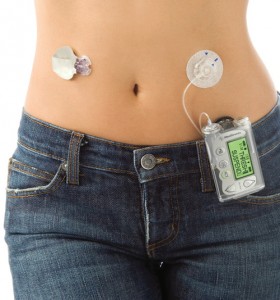I’m a couple of months into life with the new Enlite CGM sensors, so how’s it going? Have my thoughts changed since my first impressions?
Insertion. Genuinely, it has never hurt once when I’ve inserted an Enlite sensor. The marketing spiel claimed it wouldn’t hurt, but I didn’t actually believe it! I’ve got the hang of inserting it now and it’s pretty much second nature.
Accuracy. The marketing spiel proclaimed greater accuracy. Is it true? I’d say possibly. I find them to be less accurate during the first 24 hours than the old sensors which is a pain and doesn’t seem to be improved by calibrating more often. After that first day, I find they’re the same or better than the old sensors. They’re definitely more accurate when it comes to lows and highs.
With my old sensors, if they weren’t accurate I would sometimes use the tried and trusted method of fixing anything technical – turn it off and turn it back on again. For sensors, this means turning the sensor off on the pump, turning it back on again and then doing “link to sensor” so it thinks it’s a new sensor. That often sorted any issues for me, although I haven’t tried it with the Enlites before the 6 day mark.
Longevity. They’re licenced to last 6 days and all of mine so far have made it that far. I got one to 12 days. All others have lasted the full 6 days, at which point on half of them I’ve turned off the sensor, removed the transmitter, recharged it, reattached it to the sensor, turned the sensor back on and done “link to sensor”. Two hours later it asks for a calibration. When I’ve restarted after 6 days, for all but one I’ve found the accuracy has tailed off after about 9 days of use.
Positioning. Where to wear the sensor? I wore my old sensors on my back and stomach and always found the ones on my back to be more accurate. I’ve tried the Enlite on both, and found there to be no difference in accuracy between the two.
Securing. To tape or not to tape? The Enlite comes with tape attached to secure the transmitter which seems pretty robust, but I’ve never relied just on that, I’ve always added some extra tape over the top.
All in all, they’re not life changingly better than what came before, but they seem a bit more accurate and they certainly hurt less to insert. Compared to others I seem to have had a pretty smooth ride with CGM and have had few problems over the last 4 years. That experience has continued with the Enlite. It’s a step in the right direction.


Thanks Alison.. Glad they are working out for you.. What’s the score with funding for your sensors?
My sensors are NHS funded, have been for the past 4 and a half years after a very long fight with the PCT. I keep expecting them to review the funding, but so far they haven’t (touch wood). The results I’ve had since getting them are so good – HbA1c of less than 6 for the past 4 years – I’ve got good evidence to fight with should they ever think about withdrawing funding.